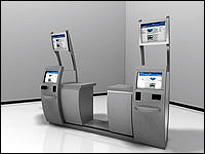In April, McCarran International Airport will begin using radio frequency identification to track bags checked in at downtown hotels along the Las Vegas Strip. The Venetian and the Luxor will be the first two hotels where off-site check-in service will be made available.
“We offered off-site check-in before 9/11, but the Transportation Security Agency shut it down after 9/11,” says David Bourgon, airline systems manager/information systems for McCarran.

The airport has hired a company—a Ft. Lauderdale, Fla.-based firm called Bags to Go—to provide the service, SpeedCheck Plus, which will cost passengers about $20. McCarran will supply RFID bag tag printers that print what looks like a normal luggage tag, with a bar code and an airport code indicating a bag’s destination. The printers have been retrofitted with RFID reader modules that can interrogate the read-only EPC Class 0 RFID inlay embedded in a luggage tag to confirm its functionality.
Bags to Go will install the printers in kiosk machines located in the lobbies of the Venetian and the Luxor. Guests will be able to check out of their hotel, check in their luggage for their flight and continue their business or vacation in Las Vegas. Bags to Go will pick up the bags and scan the bar codes on the luggage tags, then put them in the back of a van, which has a lock with push buttons for entering a code. A record will be kept of each time the van’s back door is opened or closed, and GPS will track the vehicle’s movements. If the van door is opened at a location other than one of the hotels or the airport, an alert will be sent to a control room. This will prevent the driver from stopping somewhere and sneaking a bomb into the luggage before it is put in the plane.
Upon arrival at the airport, the bags will be taken to a secure warehouse and put through an explosives-detection machine, which takes the equivalent of a souped-up CAT scan of the device. The scan of each bag will be associated with the unique serial number encoded in the bag’s RFID inlay. Airlines could then pick up the luggage and put it on a plane. If necessary, the RFID tag in the luggage will be interrogated again as it moves through the baggage system to confirm the bag has been scanned for explosives and is safe.
“This is something we are very excited about,” says Bourgon. “People love it because they don’t have to worry about checking their bags. They get through the airport more quickly, and they use the airport’s slot machines more, so there’s a benefit for us.”
McCarran is the first airport in the United States to move toward using RFID to track all the bags it handles. The airport has spent $125 million constructing new buildings comprising 225,000 square feet of space on the grounds to house bomb-detection equipment. It has also installed 4 miles of conveyors to move the bags through the explosives-detection and sortation machines.
In addition, McCarran has installed 70 RFID antenna arrays to read the bag tags at key points along the conveyor system. If the reader raises a red flag about a particular bag, for instance, that bag can be diverted off the conveyor to a station for Transportation Security Agency personnel to inspect. An inspector can read the RFID tag and call up on a screen the image of the bag taken in the explosives-detection machine. When convinced the bag is safe, the inspector can put it back on the conveyor. The system then records that the bag has been inspected and is safe to put on a plane.
Bourgon told an audience at the AIM Global Annual Showcase that the airport will bring its second RFID-enabled baggage examination facility online next month. The remote-check-in warehouse will be live in April, and four other areas with explosives-detection equipment will go live before the end of the year.
“We’ve seen about 70 percent read accuracy when scanning bar codes on bags traveling down a conveyor,” Bourgon said. “With RFID, we are getting read rates of about 98 percent. We recently resolved the problem of having dead or quiet tags enter the system, so the read rates should get up to 99 percent.”
McCarran reportedly handles approximately 70,000 bags per day.

